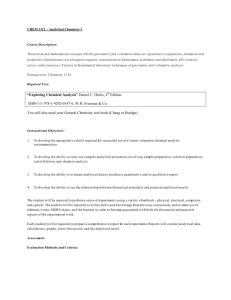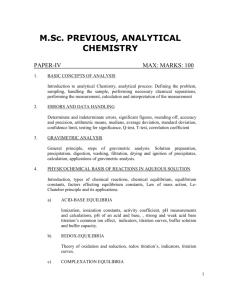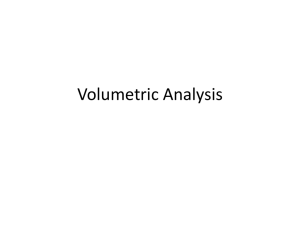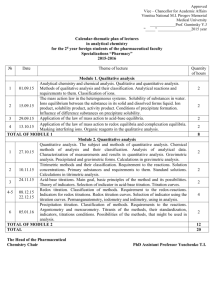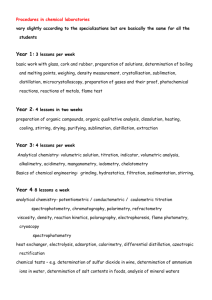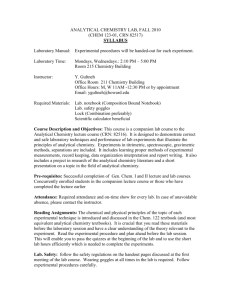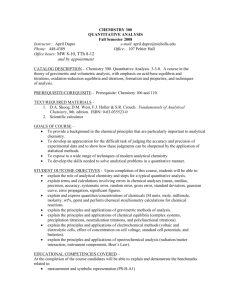CHEM 210 Syllabus - Fayetteville State University
advertisement
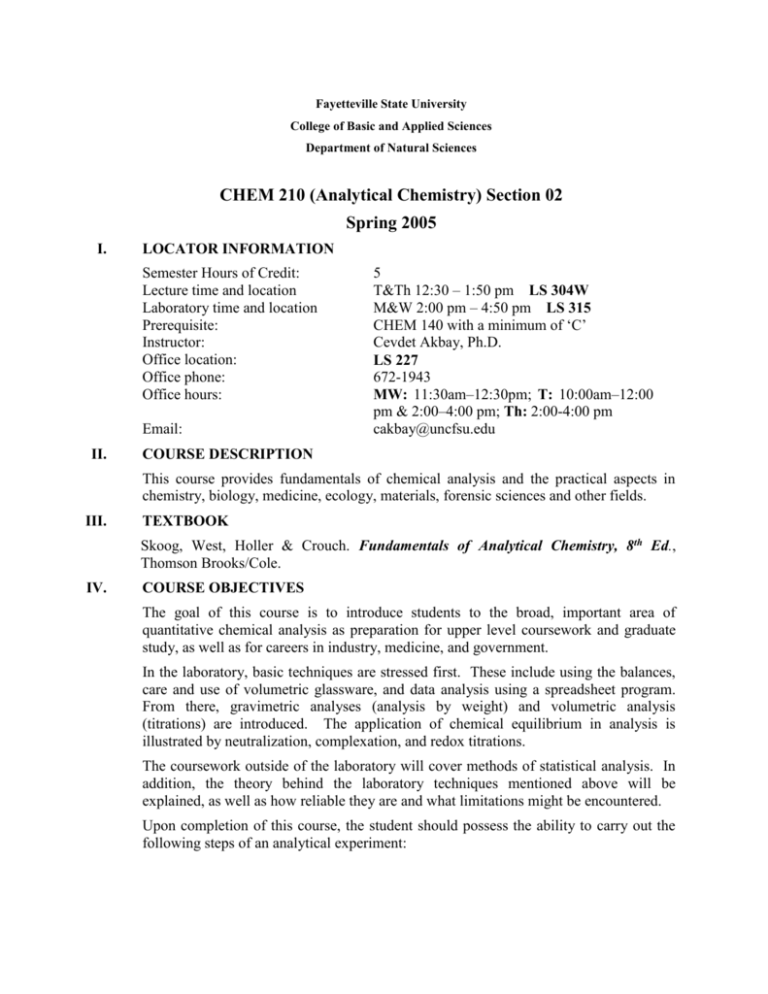
Fayetteville State University College of Basic and Applied Sciences Department of Natural Sciences CHEM 210 (Analytical Chemistry) Section 02 Spring 2005 I. LOCATOR INFORMATION Semester Hours of Credit: Lecture time and location Laboratory time and location Prerequisite: Instructor: Office location: Office phone: Office hours: Email: II. 5 T&Th 12:30 – 1:50 pm LS 304W M&W 2:00 pm – 4:50 pm LS 315 CHEM 140 with a minimum of ‘C’ Cevdet Akbay, Ph.D. LS 227 672-1943 MW: 11:30am–12:30pm; T: 10:00am–12:00 pm & 2:00–4:00 pm; Th: 2:00-4:00 pm cakbay@uncfsu.edu COURSE DESCRIPTION This course provides fundamentals of chemical analysis and the practical aspects in chemistry, biology, medicine, ecology, materials, forensic sciences and other fields. III. TEXTBOOK Skoog, West, Holler & Crouch. Fundamentals of Analytical Chemistry, 8th Ed., Thomson Brooks/Cole. IV. COURSE OBJECTIVES The goal of this course is to introduce students to the broad, important area of quantitative chemical analysis as preparation for upper level coursework and graduate study, as well as for careers in industry, medicine, and government. In the laboratory, basic techniques are stressed first. These include using the balances, care and use of volumetric glassware, and data analysis using a spreadsheet program. From there, gravimetric analyses (analysis by weight) and volumetric analysis (titrations) are introduced. The application of chemical equilibrium in analysis is illustrated by neutralization, complexation, and redox titrations. The coursework outside of the laboratory will cover methods of statistical analysis. In addition, the theory behind the laboratory techniques mentioned above will be explained, as well as how reliable they are and what limitations might be encountered. Upon completion of this course, the student should possess the ability to carry out the following steps of an analytical experiment: 1. Evaluation of a chemical problem and the selection of appropriate analytical techniques to address it, keeping in mind the chemistry behind each method and the limitations associated with it. 2. Carrying out the analytical methods in the laboratory, keeping in mind safety, the required precision, and the maximum use of laboratory time. 3. Analysis of the raw data using spreadsheet technology, arriving at not only a numerical result, but also an estimate of the precision and the statistical confidence associated with any answers to questions associated with the result. 4. Effective communication of the process behind solving the problem, including the theory behind the technique and any problems that were encountered. V. COURSE COMPETENCIES The student will apply and refine his/her previous knowledge and develop the following manual skills. a. Quantitative transfer of a solid reagent, carrying out dilutions, drying or washing volumetric glassware with the solution being measured when necessary. b. Acid-base titration with strong reagents, aiming for a precision of two parts per thousand. c. Acid-base titration of a weak acid with a strong base, aiming at the same precision. d. Acid-base titration of a weak diprotic acid or base, with the possible use of backtitration e. Preparation and calculation of buffers. f. Determination of a sulfate unknown by means of gravimetry. g. Determination of an iron sample by means of a redox titration and/or colorimetry. The student is expected to understand and show by means of word problems and tests that (s)he understands and can apply the theory behind a. The necessity to dry glassware or wash volumetric equipment with the solution being measured, including understanding when these steps are not needed. b. Acid-base titration including pH, titration curves, endpoint versus equivalence point, selection of an indicator, weak acid or base, equivalence point of a salt, hydrolysis of a salt, indicator error. c. How balances work, as well as what limits their precision and accuracy. d. Calibration of volumetric instrumentation. e. Precipitation, Ksp, problem of co-precipitation, peptization, digestion of crystals to obtain larger sizes, filtering by means of filter paper or sintered glass funnels. f. Electron-transfer reactions that occur during a redox titration procedure. g. Complexation equilibria that occur during EDTA metal analysis, including pH dependence and desirable indicator characteristics. h. Sampling techniques and statistical analysis. i. What the requirements are for a primary standard. VI. EVALUATION CRITERIA The progress of each student will be evaluated by means of three one-hour examinations given during the semester, laboratory reports, homework, quizzes, and a final examination. A. Grade distribution Three hour exams (10 3) Laboratory reports Homework and quizzes Final examination Total 30 20 30 20 100 B. Grading scale The final letter grade assigned to the student will be based upon the following numerical equivalencies. A = 90 – 100, B = 80 – 89, C = 70 – 79, D = 60 – 69, F = 59 or less VII. COURSE OUTLINE Week Jan 6th Jan 10th Jan 17th MLK Day Jan 24 Jan 31st Feb 7th Feb 14th Feb 21th Feb 28th --Mar 5th Mar 7th Mar 14th Mar 21th Mar 28th April 4th April 11st April 18th April 18th April 25 th April 27th Chapter 1 2,3, 5,6 4 Topic Introduction Tools of Analytical Chemistry Calculation in Analytical Chemistry 4 7-8 9 11 10, midterm Spring Break Calculation in Analytical Chemistry Evaluation of Analytical Method Chemical Equilibrium Equilibrium Calculation Effect of Electrolytes on Chemical Equilibria 12 13 14 16 17 18 20 24 Review Final Exam Gravimetric analysis Titrimetric methods Neutralization Titrations Application of Neutralization Titrations Complexation titration Introduction to Electrochemistry Applications of Oxidation/Reduction Titrations Spectroscopy 10:00 am-11:50 am Tentative laboratory list (see Chapter 37 of your textbook) 37A: Introductory Experiment: Laboratory Techniques 37B-1: The Gravimetric Determination of Chloride in a Soluble Sample 37C: Neutralization Titrations: Determination of Acetic Acid in Vinegar 37D: The Determination of Chloride by Titration with an Adsorption Indicator 37E: Complex-Formation Titration: Determination of Hardness of Water 37H: Iodometric Titrations: How Much Copper is there in a Penny? 37N-3: The Determination of Manganese in Steel Nutritional Chemistry: Vitamin C Determination by Titration VIII. COURSE REQUIREMENTS A. Hour exams are in the short-essay format. However, you may have multiple choice questions as well. Questions may consist of either a numerical problem to work out or a concept to explain in a few sentences. To receive full credit for numerical problems, make sure your thought process is written out clearly. B. Laboratory reports. The laboratory is an important component of the course. Laboratory procedures are on chapter 37 in your textbook. In the new version of your book, the experiments are in CD-ROM; so you have to print them out from there. Each laboratory experiment has three components. a. Pre-lab: Read the procedure beforehand. Write it out in your own words, and bring that procedure to lab, not your textbook. Write out the procedure as step-by-step instructions and make a list of equipment and chemicals at the top, with the hazards associated with each of the chemicals. b. In lab: Use your laboratory notebook to record what you have done, not what you plan to do. Record raw data directly into the notebook as you observe them; do not write weighings or buret readings on separate pieces of paper to be transcribed later into the notebook. c. Laboratory report: This is to have a title, author(s), abstract, introduction, experimental, results and discussion, and reference(s). Further details will be given. You will be trained in the use of Microsoft Excel and will be expected to use it for calculations. IX. TEACHING STRATEGIES A variety of formats will be used in this class. Typically, the class will begin with answering your questions about the homework or a ten-minute quiz, then new material in a lecture format and then in-class exercises, with discussion in an interactive format. X. BIBLIOGRAPHY Daniel C. Harris, Daniel C. Quantitative Chemical Analysis, 5th ed., Freeman (1999). Christian, Analytical Chemistry, 5th ed., Wiley. XI. DISCLAIMER To accommodate emergent circumstances, the professor reserves the right to make reasonable changes in the syllabus while the course is in progress. Any understandings between a student and the professor including, but not limited to, changes, expectations, or modifications to course requirements or procedures must be in writing and must be signed by both parties. Any question of interpretation of course requirements or of understandings between a student and the professor will be at the discretion of the professor.
